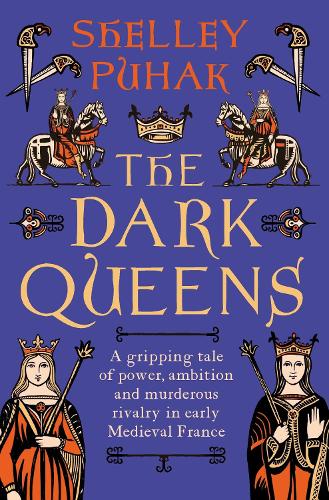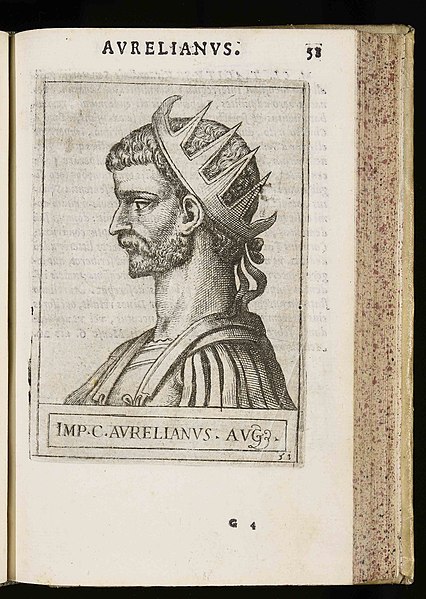Between June and September, I read three books for my AHA summer reading challenge but posted about only one of them. I have copious notes on the remaining two books and it would be a shame to waste them so let's dive in!
The first challenge I completed was to
Read a piece of historical fiction (novel, story, poem, play) set in the time or place you study.
which I met by reading Stella Duffy's novel Theodora. As you can see, I appreciate the novel's approach to its time and place (and particular its depiction of late antique Christianity), while being skeptical of some of its character development.
My second challenge was a twofer--by reading Shelley Puhak's The Dark Queens I read a history published in the past 2 years AND read a history written by a historian who who works in a day job different from your own.
To set the scene, here is the blurb of the book.
Brunhild was a Visigothic princess, raised to be married off for the
sake of alliance-building. Her sister-in-law Fredegund started out as a lowly palace slave. And yet - in sixth-century Merovingian France, where women were excluded from noble succession and royal politics was a blood sport - these two iron-willed strategists reigned over vast realms for decades, changing the face of Europe.The two queens commanded armies, developed taxation policies, established infrastructure and negotiated with emperors and popes, all the time fighting a gruelling forty-year civil war with each other. Yet after Brunhild and Fredegund's deaths, their stories were rewritten, their names consigned to slander and legend. From the tangled primary evidence of Merovingian sources - the works of the chronicler Gregory of Tours and the Latin poet Venantius Fortunatus - award-winning writer Shelley Puhak weaves a gripping and intricate tale, its characters driven by ambition, lust and jealousy to acts of treachery and murderous violence. The Dark Queens resurrects these two women in all their complexity, painting a richly detailed portrait of a shadowy era and dispelling some of the stubbornest myths about female power.
 |
The cover of the UK edition
|
|
|
|
|
|
|
|
As I mentioned in my post introducing my approach to the AHAReads challenge, this book provoked some lively and amused email chatter among my university colleagues, largely due to this overwrought blurb. On the one hand, because Merovingian history is one of my areas of interest and expertise as a scholar, I was thrilled to see a proper popular history of this amazing period being published at last. The Merovingians--who ruled the largest and longest-lasting kingdoms established after the fall of the western Roman Empire--are absolutely fascinating, but scholars have put little effort into making them accessible to wider audiences. To my knowledge, this is the first English-language trade book about the Merovingians ever published. Puhak, a professional writer and poet with an academic background in literature, approaches the sixth century with a fresh perspective and a deep knowledge of the sources.
Opening her book for the first time, the biggest thing I was afraid of was that it would take the common tack that popular histories often do, of emphasising the lack of attention to their subject. Truly, there is little more irksome than some journalist's claim that they are the first to bring to light something that scholars have been studying for decades. There was some discussion of such neglect at the beginning of the book--the author's note begins by emphasising how erased and forgotten Brunhild and Fredegund, the titular 'dark queens' were from history (xii). Puhak describes the Merovingians as obscure--which of course, to everyone other than the tiny number of us who are fascinated by them, they are. I appreciated the way Puhak grounds her exploration of this not just in the usual hyperbolic claim of rescuing people or events from the obscurity of history, but instead in a thoughtful introduction to the way these stories have been used:
This dynasty’s name is associated with secrecy because very little is, or was, known about the Merovingians. They left few traces in part because they adapted so well to the exisiting landscape, like hermit crabs, making their homes in the shells cast aside by Rome. Much in the same way, there are few traces of the queens: the abandoned shells of their biographies have been inhabited by others. Their lived experiences have been set dressing not just for opera leads, but also for fairy-tale villans and folk tale heroines, comic strip and anime characters and even, more recently, Cersei in Game of Thrones. (xiv)
I confess, as someone who isn't a particular fan of Game of Thrones,
I did heave a bit of a sigh when this was used to hook the audience at
the start of the book, but it's an intelligent choice for engaging
readers who are attracted by the blurb's description of medieval
politics as a blood sport.
I disagree with a few points of fact or interpretation (show me a historian who says they've read a book, not written by themselves, with which they agree from start to finish, and I'll show you a liar). As these points of difference interest me, I want to go into detail about them.
The biggest contention the book makes that is slipped in casually and
never explained or substantiated comes in the opening Dramatis Personae (a clever way to introduce historical figures as characters), where Radegund, a nun, saint, and former queen who is one of the sixth century's most compelling women, is casually described as the unnamed mother of the
bastard pretender Gundovald (xix). This seems like a contradiction in terms: Radegund was once married to the Merovingian King Chlothar, from whom Gundovald was alleged to derive his royal ancestry. She never, according to all surviving sources, had children. This is clearly a misprint--elsewhere, Puhak refers to Chlothar's penchant for sexual misbehaviour and describes Gundovald's mother as 'the wife of a mill worker.' (37) Elsewhere, Puhak describes how Radegund ‘had been at court at the time of
Gundovald’s birth and had first-hand knowledge of the king’s
extramarital dalliances. Radegund, in particular, had kept her husband
under surveillance in order to avoid his sexual advances, so her
testimony carried great weight’ (181). Indeed, Radegund’s extreme pursuit of a rigorous Christian lifestyle is convincingly framed as both a shield and a weapon against her husband (36-37). The assertion that Radegund was Gundovald's mother was such a surprise to me that I kept hoping to see evidence for it, but such was not to be.
My second sticking point, like my first, also features Radegund. A central contention of the longest chapter of my book, Friendship in the Merovingian Kingdoms, is the argument that Radegund, as a woman with considerable authority derived from her position as a former queen and living saint--was the literary patron of a young Italian poet, Venantius Fortunatus, who composed some of the most significant Latin poetry of the sixth century on her orders, and for the purpose of achieving her diplomatic, cultural, and spiritual aims. My conclusion, which draws on the manuscript transmission of these particular poems and work of Latin philologists, is that Radegund did not write these poems herself, but that she was deeply involved in their composition. My principle interest is not Radegund's authorship but her power and authority--and the poems provide ample demonstration of the latter.
For Puhak, the question of authorship is much more important and she disappointingly dismisses the case against Radegund's authorship as typical sexism on the part of historians:
...naturally, the poem’s
authorship is still in question, since, clearly, a woman with a
spectacular education and a sharp mind, a woman who regularly wrote
poems, couldn’t possibly have written this one. Instead, historians have
long claimed that it was written by Fortunatus, even though the voice
and tone and markedly different from his other work. In recent years
some have reconsidered and now fully attribute the poem to Radegund, or
at least acknowledge that she must have had significant input in its
composition, even if Fortunatus later helped with the form and metre. (41)
This is defended in more detail in the notes (see p 340), where Puhak
writes that she draws on her academic background in literature to judge
that the difference between the depiction of emotions in this poem and
Fortunatus’s other poems is significant even when compared to
Fortunatus’ other poems in the voices of women (6.5 and 8.3). This does not fully address the issues raised by the evidence of the Latin vocabulary, with its clear parallels to Fortunatus' other writings or the manuscript evidence, which demonstrates that readers saw the poems as his, not hers, even while they noted the prominence of the poems' evocation of Radgeund's voice. The argument in favour of Radegund as a collaborator and literary patron harmonises extremely well with Puhak's overall thesis about the significance of Merovingian women. Commissioning works of literature was a sign of power and authority--and discussion of Radegund's involvement in the creation of the three Byzantine poems would have added a welcome subtlety to her portrayal of the different kinds of clout Merovingian women could wield.
They are known as the Byzantine poems because of their audience. Radegund commissioned Fortunatus to write three long, elaborate poems-- a description of the destruction of her homeland, a letter to her cousin Artachin, and an extremely elaborate thank you note--as a cornerstone of her strategy in an act of international diplomacy. She was an avid collector of the relics of saints from around the Mediterranean world, and wanted a piece of the cross on which Jesus was crucified for her collection. A piece of this precious relic was held by her world's most powerful empire--Byzantium, which ruled what had been the eastern half of the Roman Empire, a domain covering Anatolia, stretching through Palestine and Syria, and including, tentatively, North Africa and scatted parts of Italy and Spain, reclaimed in bloody and financially ruinous wars in the first decades of the sixth century.
In this period, religion was never separate from politics, and Fortunatus' poems served to prove that the Merovingians were a force worth reckoning with. The mission required the approval and support of Sigibert and Brunhild, the king and queen of the Merovingian kingdom in which Radegund's monastery was located. Radegund's way in to the Byzantine court was through her family connections--after her future husband, Chlothar, wiped out her family and their kingdom, her cousins who escaped the slaughter took refuge in Constantinople. The Byzantine Empress Sophia (and her husband, the Emperor Justin II), were successfully persuaded to grant a relic of the cross. I was disappointed in Puhak's discussion of the messengers who delivered the relic:
Legates usually handled only serious diplomatic matters; they were not
average deliverymen for gifts from one woman to another. While the
jeweled Bible was being delivered to Holy Cross Abbey, the legatarii
were clearly conducting other business. (43)
The idea that the delivery of the relics was a departure from the legates' usual serious business doesn't make sense. Gifts between a queen and an empress were serious business. Especially if they were spiritually significant relics which served to cement a diplomatic relationship!
 |
The cover of the US edition
|
In short, I appreciated, but did not always agree with Puhak's handling of
Merovingian sources. Mostly, she avoids the mistake, commonly made by journalists and writers who lack historical training, of ascribing modern morals and
motivations to medieval people, whose values and frames of reference are not ours. One area in which this slips a little is her approach to medieval religiosity. For instance, the deeply religious bishop and history Gregory of
Tours is described as credulous and naïve. (309) Not words I would use
to describe a man who survived and made a highly successful career
through
decades of volatile Merovingian politics! Similarly, Gregory’s
account of the religious motivations behind civil strife in other parts
of the early medieval world
is dismissed out of hand ‘Gregory, though, found religion at the heart
of everything; he had no contacts or special knowledge of Visigothic
Spain.’ (142). It would be more accurate to say that Gregory’s position as a
metropolitan bishop (a role which put him in charge of other bishops in his district) gave him unique access to regional and international networks of communication.
While
Puhak underestimates ability of the church and its officials to communicate across distances, it sometimes seems that she overestimates
these powers when they were in the hands of secular noblemen. I was
intrigued but not entirely persuaded by her hypothesis that messengers helped disaffected Merovingian nobles who
wanted to exploit the inefficiencies that were routine in ruling and
administering a premodern state (56-7). Similarly, I wondered about the
assertion that Merovingian nobles launched ‘whisper campaign’ in favour
of the bastard pretender Gundovald and against the kings Chilperic
and Guntram. (134) How successful would this haven been in a world where
communication across distances was difficult
and fragmentary for everyone without significant political power and social position?
On a more positive note, I was fascinated by Puhak's creation of figures from the pages of the bishop and historian Gregory of Tours' Histories as characters. Arguably, this is actually closer to Gregory's biased, gossipy, and eminently readable style of describing his contemporaries than the often desperately dull dissection of noblemen like Guntram Boso or Dynamius in academic scholarship (I number myself among the guilty here!) Puhak's style and approach open up other perspectives. Her history-writing, because of its focus on narrative and character, has a much
easier time breathing life into the motivations of people of the past. I enjoyed the portraits of the nobleman Mummolus as ambitious (139) and the bishop Edigius as cautious (58-59). I also enjoyed the characterisation of the turncoat nobleman Guntram Boso (173-174). The story of the doomed Merovingian prince Merovech, Brunhild's second husband, is told with drama and accuracy (112). In sum, Puhak's handling of the minor characters of Merovingian history is enjoyable and persuasive.
I was less convinced by the characterisation of Fortunatus. In particular, I wondered at the description of him as ‘increasingly repulsed’ by female
bodies and sexually attracted to men (118). To a twenty-first century eye, excerpts from his poems to men are certainly suggestive, but his informal poems to Radegund, and her adopted daughter Agnes have a tone of genuine affection and delight in their company. They are among my favourite poems in his collection and I wish more people knew them. Yet even on a subject I know incredibly well, Puhak still taught me something new. From her notes and bibliography, I learned that several of Fortunatus' poems have been excerpted in anthologies of poems about same-sex desire from the Middle Ages. How did I miss that? The discussion of affection between men in my own book is limited and incomplete without taking this history into account.
This leads me to one of my biggest bugbears in popular discussion of the past--the 'historians claim they were just good friends' trope. It is indisputable that historians of the past and present have ignored and elided evidence of historical queerness. At the same time, applying modern labels and identities to the past is not as simple as it sometimes first appears. Fortunatus' expressions of affection for his male friends may look unquestionably homoerotic to us but would medieval readers have shared
our reaction? What frames of reference and terminology did they use to articulate and understand their experiences? Puhak inspires me to reread Fortunatus and think about the queer potential of his work in more detail.
There are a number of other points where Puhak brings a fresh perspective to well-trodden ground. Hers is the first work of scholarship I have read which makes the argument that a third of the Treay of Andelot, a significant diplomatic agreement intended to end the bitter civil wars which plagued the Merovingian kingdoms through their history, focused on 'the affairs
of Merovingian women.’ (218) Again, this made me want to reread the sources with new eyes.
I conclude this post without much--any--discussion of Puhak's treatment of Brunhild or Fredegund, the two titular queens, and so perhaps this sounds like a disgruntled account of the book I wanted to read (or write myself), rather than the excellent book that Puhak has written. Let me attempt to fix that. A particular highlight of Puhak's account of both queens is her geographic
awareness--her account successfully portrays them as real people in real landscapes (pp 67-68 is an especially good example). She makes a convincing case for the importance of Brunhild and Fredegund, not just as queens, but as powerful rulers, arguing that combined they controlled more territory for a longer period of time than any
other early medieval ruler (262). Puhak concludes with a discussion of what she hopes her book might mean for her readers:
As a girl, I gobbled up biographies of female historical
figures: activists, writers, and artists, but few political leaders, and
even fewer from so deep in the past. I don’t know what it would have
meant for me, and for other little girls, to have found Queen
Fredegund’s and Queen Brunhild’s stories collected in the books I read.
To discover that even in the darkest and most tumultuous of times women
could, and did, lead. (305)
Some of my earliest reading about the past was also biographies of women, where I too found few accounts of women in charge. Puhak has made a wonderful contribution towards filling this gap. I will be buying myself a copy of
the Dark Queens. I recommend it as a compelling introduction to the Merovingian world.












